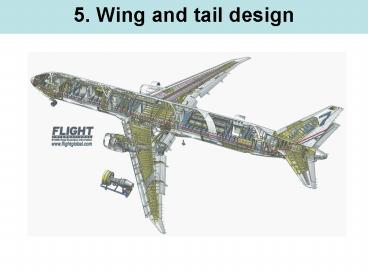5' Wing and tail design - PowerPoint PPT Presentation
1 / 28
Title:
5' Wing and tail design
Description:
The historical evolution of airfoil sections, 1908 1944. ... inboard aileron. outboard aileron. Wing area S is found in the engine selection process ... – PowerPoint PPT presentation
Number of Views:444
Avg rating:3.0/5.0
Title: 5' Wing and tail design
1
- 5. Wing and tail design
2
Elements of the Airfoil Lift Curve
cl cl,max
cl,a
a0 0 a0
acl,max a
3
Evolution of NACA airfoil sections
The historical evolution of airfoil sections,
1908 1944. The last two shapes (N.A.C.A. 661
-212 and N.A.C.A. 74 7A315) are low-drag sections
designed to have laminar flow over 60 to 70
percent of chord on both the upper and the lower
surface. Note that the laminar flow sections are
thickest near the center of their chords.
4
Airfoil Configuration Characteristics
Mean camber line
Upper surface
Trailing edge
Chord line
Lower surface
Leading edge
5
Velocity ratio over upper and lower surfaces
Upper surface, cl0.22
Lower surface, cl0.22
(v/V)2
x/c
6
Typical Airfoil Data (NACA TR 824)
3 millionltRelt9 million std.roughness at Re6
million
Split flap dF60o
cl
No flap
Drag bucket
cm,a.c.
cM,c/4
Angle of attack
Angle of attack
7
High Lift Devices The Flap
8
Cl,max 3.2 2.8 2.4 2.0 1.6
Increase in CL,max 2- Slot Flap
Cl,max1.61 (df /45)
0 20 40 60 df
(degrees)
9
Airfoil with Slat
slat
Separation is delayed, thereby increasing the
stall angle
slot
10
Effect of Slat on Lift
11
High Lift Devices for Maximum CL
Cl,max
Flaps Slat
Plain airfoil
12
Supercritical Airfoils
13
Conventional supercritical airfoils
Pressure distributions
Strong shock wave
Weak shock wave
14
Supercritical Airfoil Drag Compared to NACA
Airfoil Drag
NACA 641-212 airfoil, t/c 12
Slotted supercritical airfoil, t/c 13.5
.02
.012
0
Cd
Integral supercritical airfoil, t/c 11
0 .72 M .84
15
Normal Force Coefficient of Supercritical Airfoil
vs. NACA Airfoil
1.4 1.0 Cn
.4 0
Supercritical Airfoil, t/c11
NACA 641-212 Airfoil, t/c12
.64 .72 M
.84
16
Lift on a Finite Wing
2-D Lift Distribution
b
c
3-D Lift Distribution
V
17
Wing Trailing Vortex System and Associated
Downwash Field
Trailing Wingtip Vortex
Bound Vortex
Downwash
Trailing Wingtip Vortex
18
Boeing 727 Trailing Vortex
19
Wing with high-lift devices
Wing area S is found in the engine selection
process
centerline
inboard aileron
leading-edge slats
Lle
root chord, cr
outboard aileron
tip chord, ct
mean aerodynamic chord, MAC
trailing edge flaps
half-span, b/2
Ab2/S is selected, thereby determining span b
20
Lift characteristics of the 3-D wing
Lift curve slope of the wing
Prandtl-Meyer function
Sweepback angles
Taper ratio lct / cr
Airfoil lift curve slope k cl,a / 2p
21
Untwisted, Constant-Section Wings
from Fig. 4.1.3.4-21a
wing maximum lift
airfoil maximum lift
Mach number correction from Fig.
4.1.3.4-22 (extrapolation to M0.8 required)
wing a for maximum lift
Mach number correction from Fig. 4.1.3.4-21b
Wing lift curve slope
22
CL,max in Landing and Take-off Configurations
Condition Typical Flap Deflection (in
degrees) Take off 15ltdTElt25 dLElt20 Landing
40ltdTElt50 or 60 dLElt20
airfoil with trailing edge flaps
(Dclmax)base is the section maximum lift
increment for 25 percent-chord flaps at the
reference flap-deflection angle from Fig.
6.1.1.3-12a, k1 is a factor accounting for
flap-chord-to-airfoil-chord ratios other than
0.25 from Fig. 6.1.1.3-12b, k2 is a factor
accounting for flap deflections other than the
reference values from Fig. 6.1.1.3-13a, and k3
is a factor accounting for flap motion as a
function of flap deflection from Fig.
6.1.1.3-13b.
23
DCL,max for the Wing with Trailing Edge Flaps
trailing edge flaps
leading edge slats
(Note that leading edge flaps are rarely used.
See p.251-258 in Torenbeek regarding high lift
devices)
24
Wing with high-lift devices
leading-edge slat span ratio bslat/be (b1b2)/be
centerline
be
b2
b1
mean aerodynamic chord, MAC
trailing edge flaps
half-span, b/2
25
Summary of Design Lift Characteristics of the Wing
Airfoil Choice NACA 64,-212 (ROOT) NACA
64,-209 (TIP) Aspect Ratio A 6.25 Taper
Ratio l .333 Flap Type (cf /c) Fowler,
(23) Spanwise Extent (hi and ho) 16.4 and
76.0 Rated Area (SWf /S) 0.53
26
Horizontal tail sizing
lh
0.05MAC
CMAC/4 point
VhShlh/S(MAC) Volume coefficient of the
horizontal tail L1011 Vh0.93
Sh, horizontal tail planform area
27
Sizing the Vertical Tail
VvSvlv/S(MAC) Volume coefficient of the vertical
tail L1011 Vv0.59
lv
Sv, vertical tail planform area
28
3-View Drawing of the Preliminary Design

